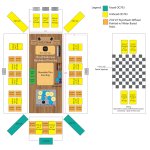RecordingMaster
A Sarcastic Statement
Hey all!
I have attached my studio plan to this thread, but here's a little preface...
Soon I will be moving from my current house (where my live room is in the basement and control room upstairs) into a larger one-room studio I am "building" in my new house's basement. While the ceiling is only 7', I am hoping I can deal with things and still get a good usable room for mixing and tracking. I have been making loads of bass traps and broadband absorbers and have a plan in mind. I also picked up a few Auralex Q fusors to help offset all the absorption I will need - mainly around the drums to keep em crispy. I tried to sort of do a modified Live End Dead End concept where the mix spot has more absorption but the drum area on the far end is a little more lively but still with adequate absorption due to potential problems with lower ceilings.
I will be building a wall to the left side of the studio to close it off and putting a steel "door in a frame" to access the studio from the rest of the basement. So other than the left wall, everything else is surrounded by outside walls - cinder block covered with pink insulation, vapor barrier and sheet rock.
Optimally, I would insulate the entire ceiling and just cover it in fabric, but that would allow too much sound to pass intpo the upstairs. So I will be filling the ceiling joists in roxul safe n sound and then covering that with sheet rock and treating the ceiling from the inside. I need to try to keep the ceiling as high as possible so here is what I've come up with. I already have all the acoustics materials in the plan, ready to hang.
How's this???
I have attached my studio plan to this thread, but here's a little preface...
Soon I will be moving from my current house (where my live room is in the basement and control room upstairs) into a larger one-room studio I am "building" in my new house's basement. While the ceiling is only 7', I am hoping I can deal with things and still get a good usable room for mixing and tracking. I have been making loads of bass traps and broadband absorbers and have a plan in mind. I also picked up a few Auralex Q fusors to help offset all the absorption I will need - mainly around the drums to keep em crispy. I tried to sort of do a modified Live End Dead End concept where the mix spot has more absorption but the drum area on the far end is a little more lively but still with adequate absorption due to potential problems with lower ceilings.
I will be building a wall to the left side of the studio to close it off and putting a steel "door in a frame" to access the studio from the rest of the basement. So other than the left wall, everything else is surrounded by outside walls - cinder block covered with pink insulation, vapor barrier and sheet rock.
Optimally, I would insulate the entire ceiling and just cover it in fabric, but that would allow too much sound to pass intpo the upstairs. So I will be filling the ceiling joists in roxul safe n sound and then covering that with sheet rock and treating the ceiling from the inside. I need to try to keep the ceiling as high as possible so here is what I've come up with. I already have all the acoustics materials in the plan, ready to hang.
How's this???


 Yes, I agree, they aren't "real" diffusors by any stretch. However, I'd hope they'd provide at least a slight bit more diffusion than a bare wall until I can afford real diffusion (hopefully)? The other reason I went that way for now is space. These only protrude 3" off wall where as a true diffuser to diffuse anything below, say 800hz, would have to be much deeper. A 10' wide room can get crowded real fast. So I'd hope these can at least diffuse as low as, say 1k or something, just to keep cymbals and things crispy up there in the high end. They are "based on a quadratic mathematical equation", but I take that with a grain of salt. They are very firm EPS Styrofoam which i need to paint to make more reflective.
Yes, I agree, they aren't "real" diffusors by any stretch. However, I'd hope they'd provide at least a slight bit more diffusion than a bare wall until I can afford real diffusion (hopefully)? The other reason I went that way for now is space. These only protrude 3" off wall where as a true diffuser to diffuse anything below, say 800hz, would have to be much deeper. A 10' wide room can get crowded real fast. So I'd hope these can at least diffuse as low as, say 1k or something, just to keep cymbals and things crispy up there in the high end. They are "based on a quadratic mathematical equation", but I take that with a grain of salt. They are very firm EPS Styrofoam which i need to paint to make more reflective.
